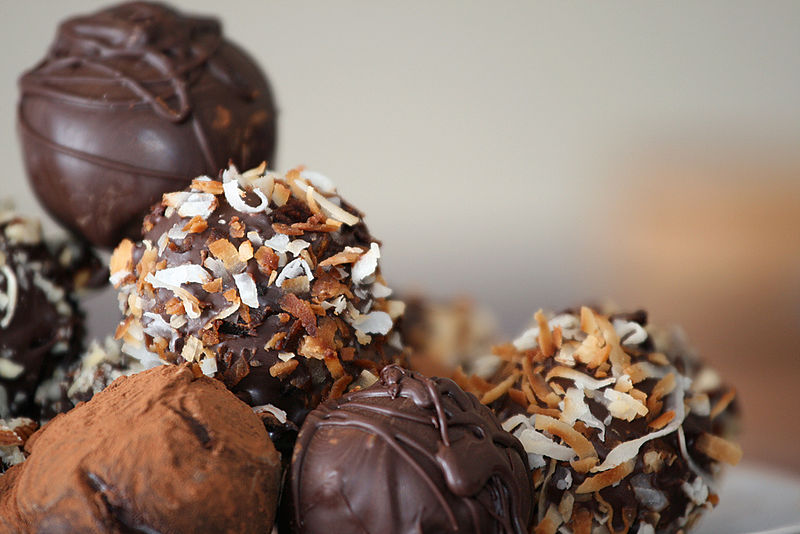Happy Valentine’s Day! We have a great article on CHOCOLATE for you this week, from Shannon Sterne, who is a dancer and nutritionist. She is also the founder of Step Wise Wellness Consulting – specializing in nutrition and wellness consultation for dancers. It reminds me of what the IPhone’s SIRI says, when you ask “her” the question:
“What is the meaning of life?” — you can get different answers from “her”, but my favorite goes something like:
“According to the best interpretation — it’s Chocolate”!
Enjoy ! And have a love and chocolate-filled Valentine’s Day!
Jan Dunn, Editor, Dance Wellness

by Shannon Sterne, RD, MS, MA
Valentine’s Day is here, and according to most Americans nothing says “I love you” like a box of chocolates. More than 60 million pounds of the confection will be sold in the days surrounding February 14th generating sales upwards of $350 million. If you’re a dancer concerned about your weight, this go-to gift for Valentine’s Day could elicit more grief than passion.
Gifted to us by friends, lovers, and spouses as signs of love and affection, chocolate-covered fruits and nuts, nougats, truffles, and caramels abound, and historically, we are weak to resist chocolate’s sweet pleasures. Often referred to as irresistible, decadent, indulgent, and sinful, chocolate is consistently reported by women to be their number one food craving. Some even joke that chocolate should be its own food group.
Food cravings can be particularly problematic for dancers as we strive to maintain a svelte figure while ensuring that we have enough energy to make it through a full day of classes, rehearsals and performances. Some dancers will go out of their way to avoid the foods they crave; afraid that eating one handful of M&Ms will lead to eating the entire bag, making them look terrible in their tights and impossible to lift. Consuming chocolate then becomes a guilty pleasure.

Ironically, attempting to deny or control your desire for chocolate can increase stress levels leading to stronger cravings, and often to binge eating. Eventually “will power” runs out and we give in to these cravings; and feelings of failure and guilt accompany our indulgence. Removing the prohibition on chocolate, and eating small amounts to satisfy cravings, chocolate becomes a source of comfort rather than guilt.
Our cultural obsession with chocolate may be due in part to its rarity in our diet. Most of us do not eat chocolate regularly with our meals, instead reserving chocolate for snacks, desserts and special occasions. It is not something that we “should” eat, but is instead a delicious escape from the daily grind. It is a treat, a pleasure, a comfort. And most often, chocolate is eaten in spurts. Late in the day (after many hours of rehearsals); when we are feeling stressed (learning new and difficult choreography or before performances); and for the ladies, during “that time of the month.”
What makes chocolate so desirable? Pure chocolate, harvested from the seeds of the Threobroma cacao tree, is high in fat, which gives chocolate its rich and creamy melt-n-your-mouth texture. Chocolate also contains the compounds theobromine and caffeine, which provide a mental lift. But very few Americans consume pure chocolate. The chocolate bars and candies consumed in the US are laden with sugar. Together, this combination of fat and sugar, triggers the release of several neurotransmitters, including serotonin and endorphins, which result in a sense of well-being. “Chocoholics” become addicted to this chemical rush, which they associate very strongly with chocolate.
But chocolate isn’t all bad. Research continues to point to the health benefits of regular consumption of small amounts of chocolate, particularly when it comes to heart health. With more antioxidants than green tea and blueberries, chocolate is also high in magnesium and copper, and – if it’s milk chocolate – calcium. But not all chocolate is created equal. The more processed it is, the fewer nutrients it contains. Raw cacao, at room temperature or heated just to its melting point, will provide the most nutrients. Dark chocolate is your next best bet – the higher the cacao content, then generally, the more antioxidants. White chocolate is actually made from cocoa butter (the fat extracted from chocolate) but otherwise contains no chocolate, and therefore none of its benefits. However, it is important to remember that chocolate in any form is high in fat and calories. Adding chocolate to your diet solely for health purposes is not recommended, especially if you are watching your weight.
So what’s a dancer to do? If chocolate cravings get the best of you, try these tips for satisfying your desire for chocolate without giving in to obsession. [Read more…]




